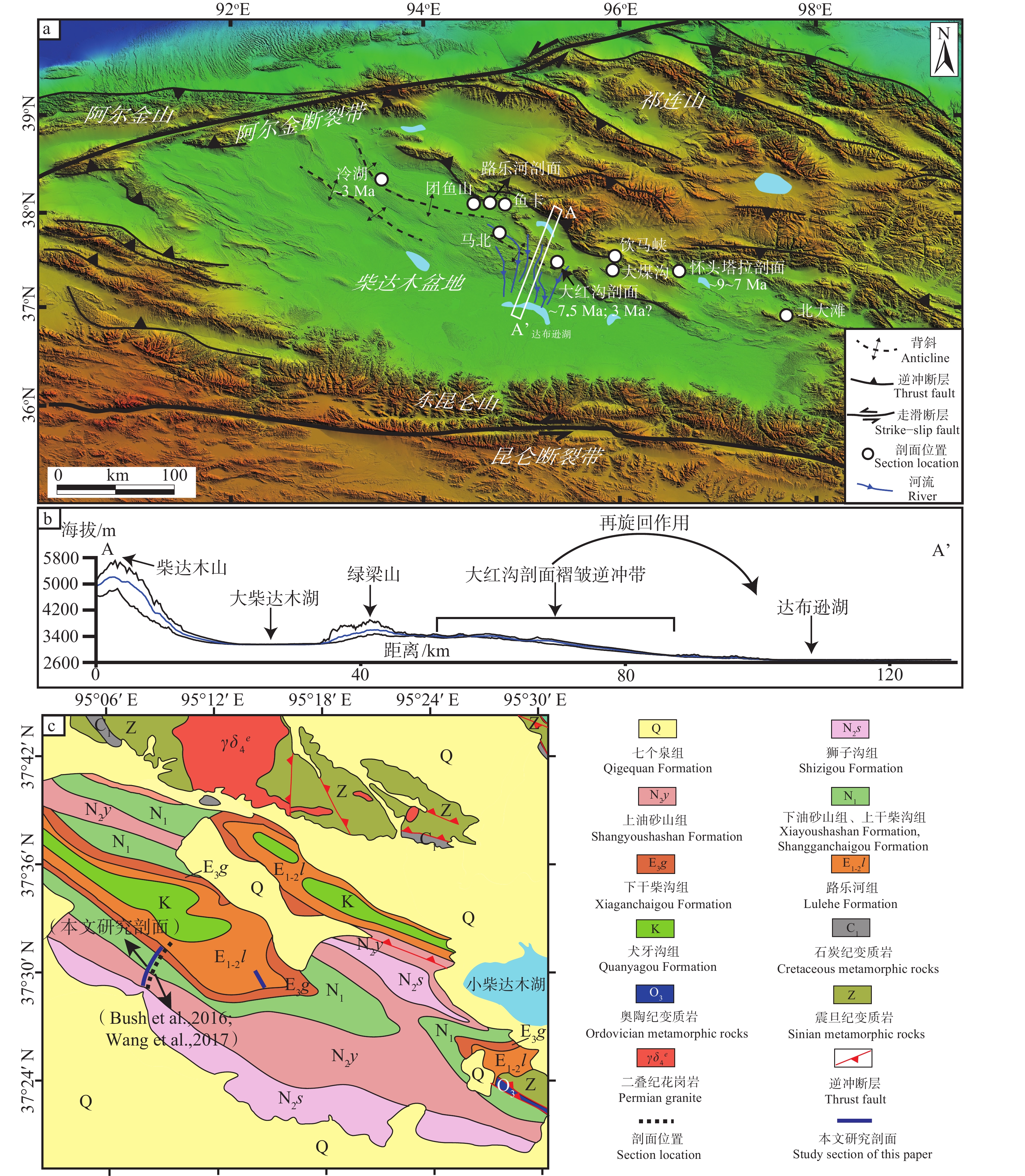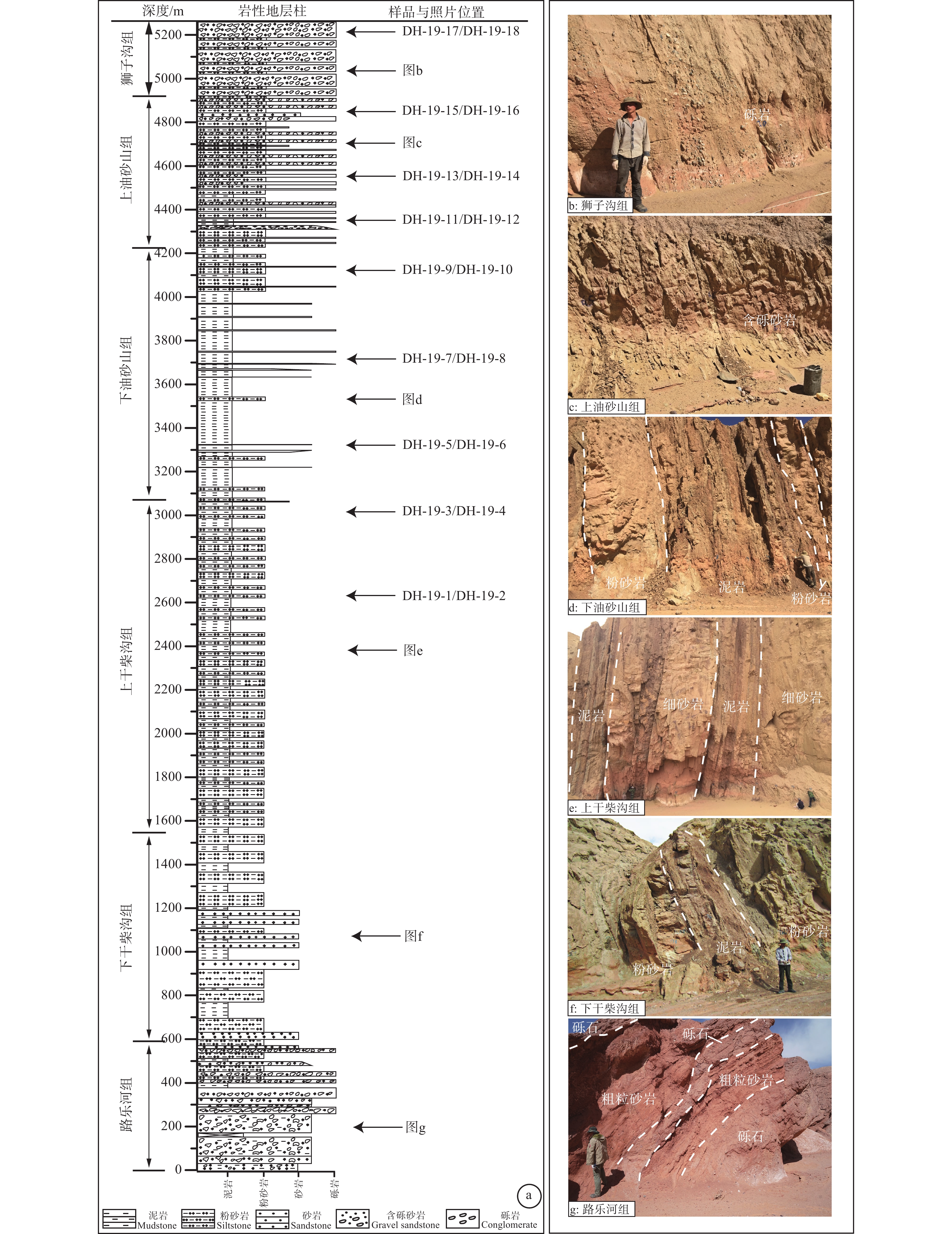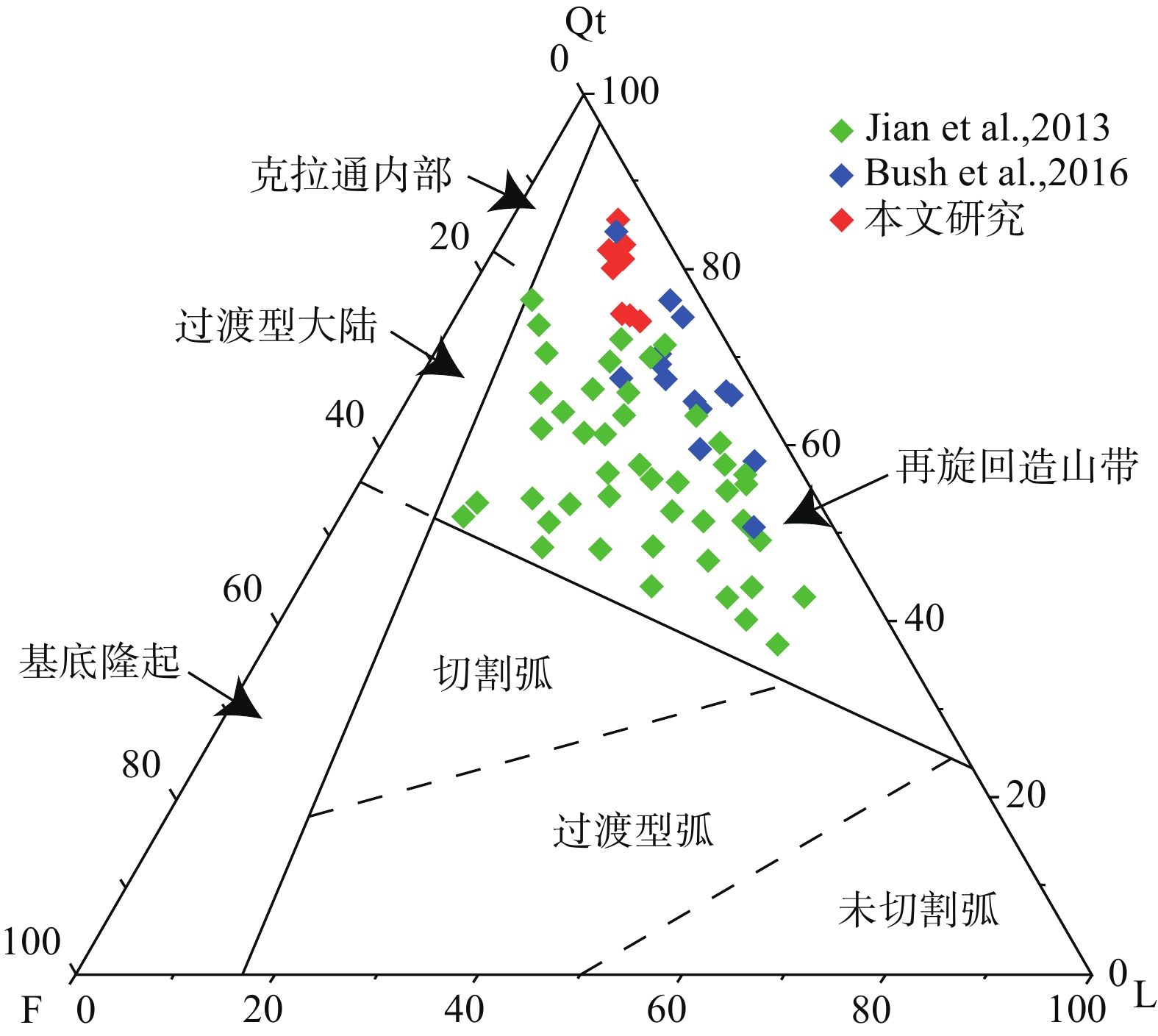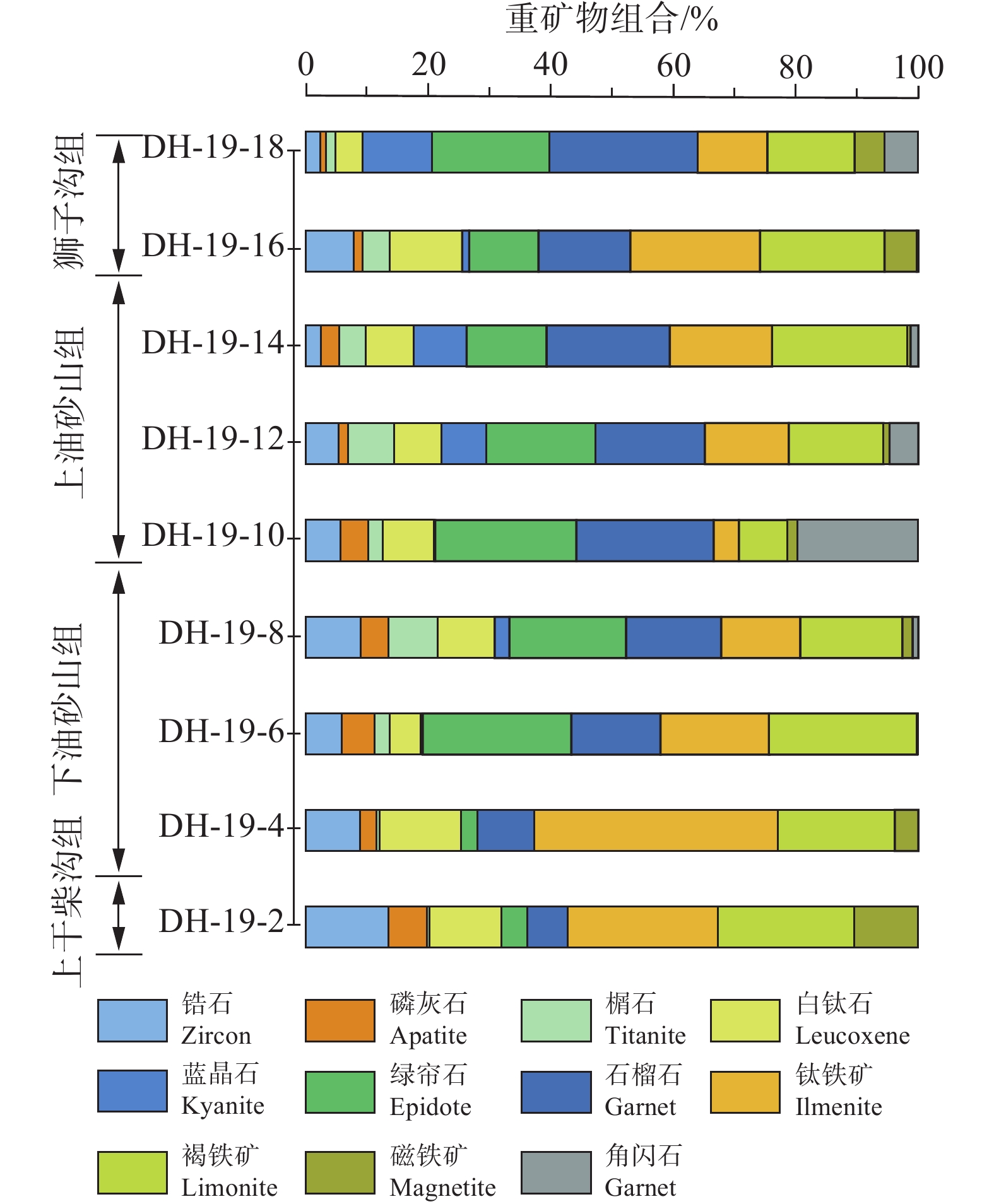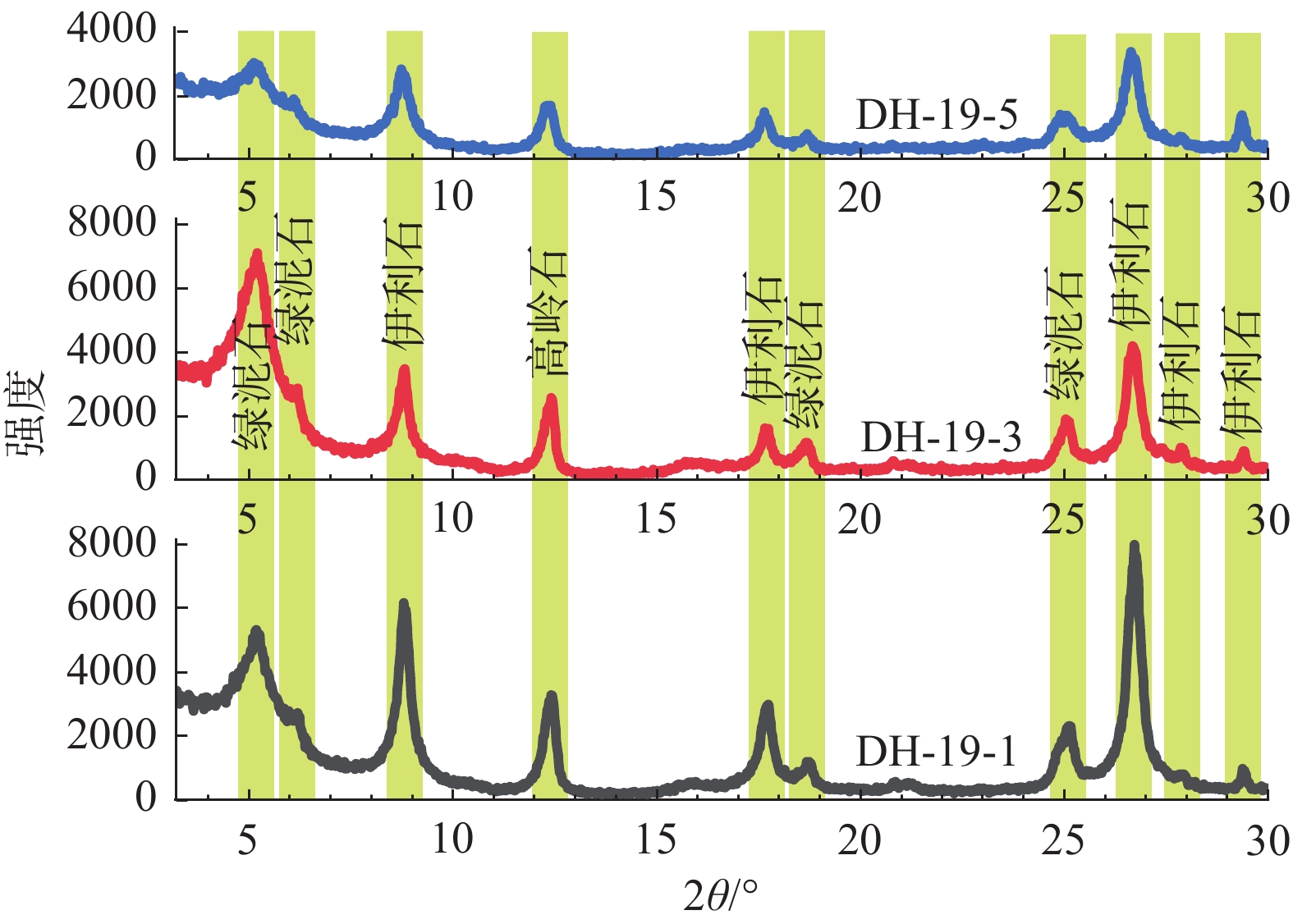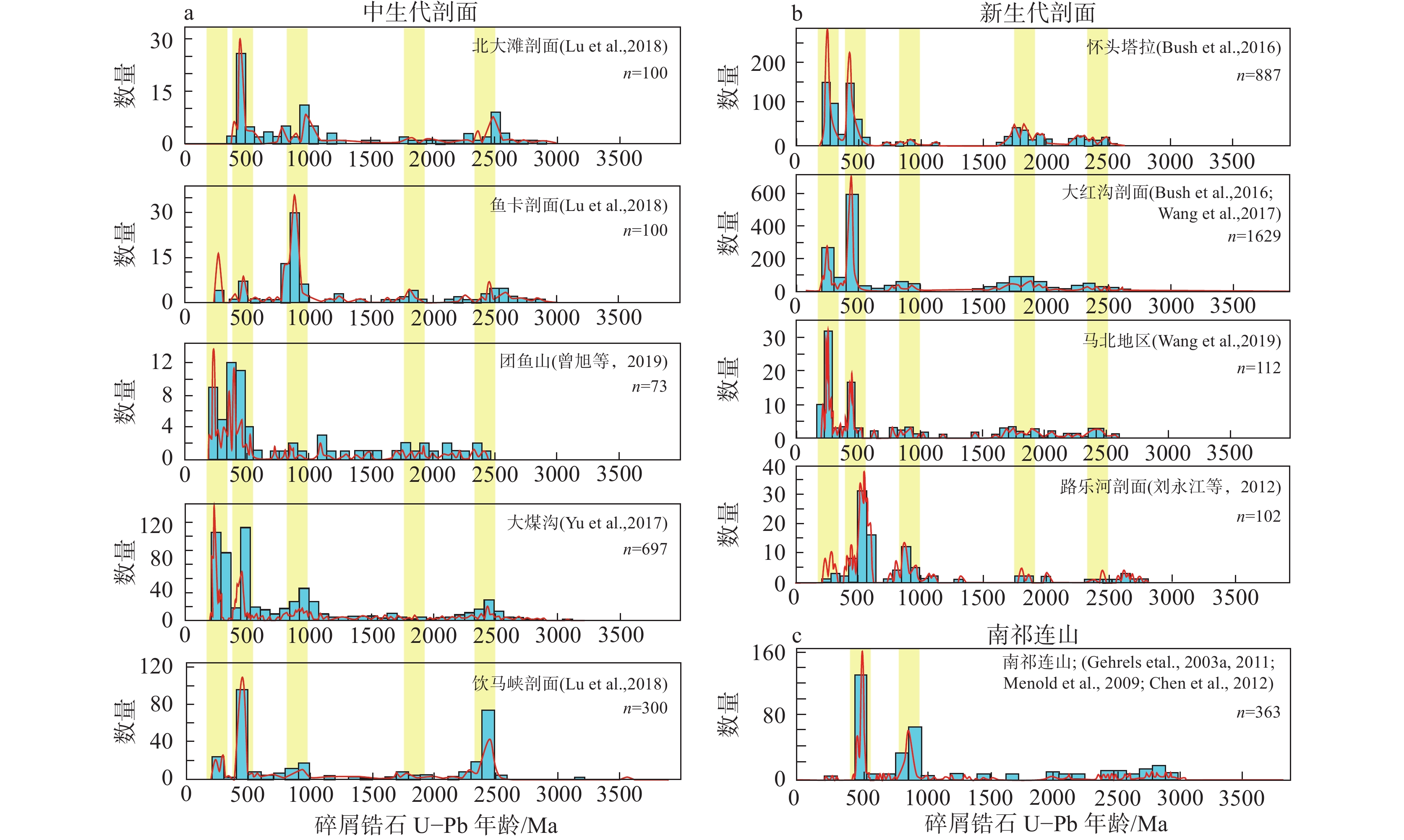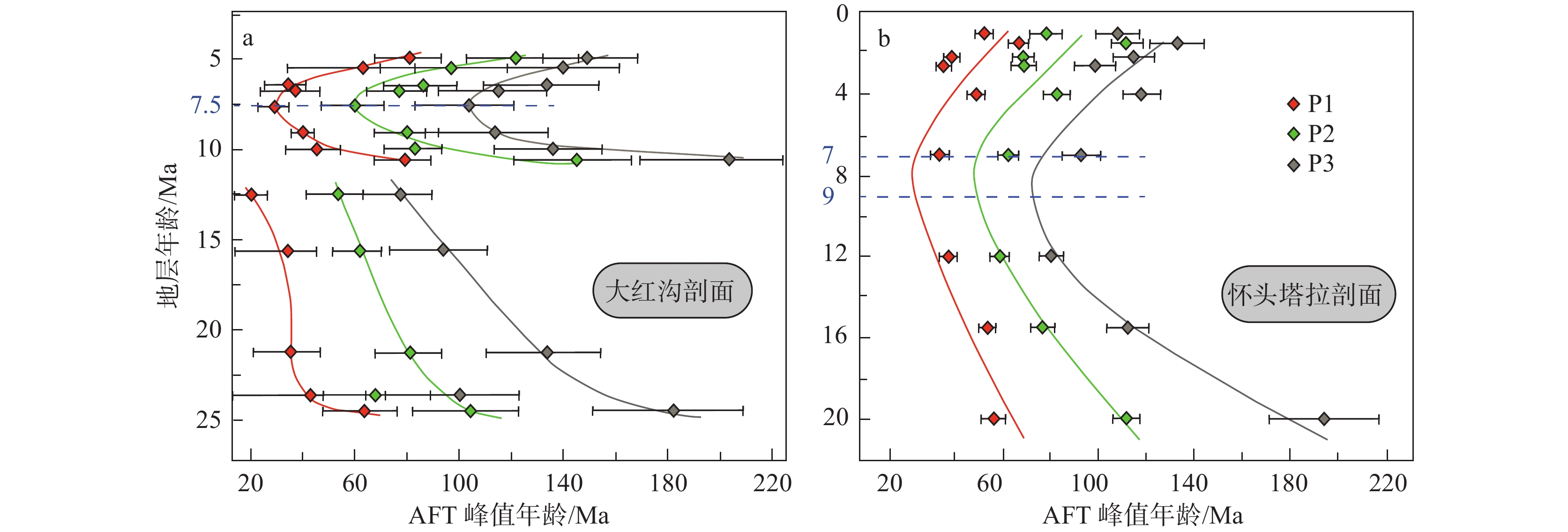Sediment recycling in the northern Qaidam Basin margin during the Cenozoic: A case study from the Dahonggou section
-
摘要:
研究目的 近来,越来越多的研究显示沉积物再旋回作用在构造事件反演、沉积物源区识别以及风尘沉积溯源等方面具有重要作用。
研究方法 为了探究柴达木盆地新生代沉积物再旋回作用,本文对柴北缘大红沟剖面的砂岩进行了薄片鉴定、碎屑颗粒统计和重矿物等分析,以及对泥岩进行了主微量与稀土元素、黏土矿物等分析。
研究结果 大红沟剖面泥岩的主微量元素与稀土元素分别表现出相似的大陆上地壳(UCC)和球粒陨石标准化配分模式,可能表明沉积物已完全混合或发生再旋回作用;砂岩的主要成分为石英以及少量的长石和岩屑,其中岩屑主要由沉积岩屑组成,表明其源区主要为再旋回造山带;剖面上部稳定重矿物的含量和锆石、电气石和金红石(ZTR)指数突然降低,这表明后期可能主要为近源堆积;相反,黏土矿物中易发生分解的绿泥石的含量在剖面上部突然增加,这也表明此时的物源区更近,有更多的绿泥石保存下来。
结论 综合已有的地层沉积相、砂岩薄片以及碎屑锆石U−Pb年龄等资料,认为柴北缘逆冲褶皱带内广泛分布的侏罗系和白垩系沉积岩曾经历过大规模的沉积物再旋回作用,是盆地新生代地层的重要源区之一;近来的碎屑磷灰石裂变径迹分析表明,柴北缘新生代沉积岩在9~7 Ma经历了显著的沉积物再旋回作用;随着逆冲褶皱作用进一步向盆地内部扩展,~3 Ma以后盆地北部的隆起区沉积岩再次经历沉积物再旋回作用,可能成为柴达木盆地第四纪湖泊以及中国黄土高原黄土的重要源区。
Abstract:This paper is the result of geological survey engineering.
Objective Recently, more studies show that the sediment recycling plays an important role in the inversion of the tectonic events, the identification of sediment source areas and the sources of eolian dust.
Methods In order to explore the Cenozoic sediment recycling in the Qaidam Basin, this paper conducts thin section identification, detrital framework grain composition and heavy mineral analysis of sandstones, and major, trace, and rare earth elements, and clay minerals of mudstones of the Dahonggou section in the northern Qaidam Basin.
Results The major, trace, and rare earth elements of mudstones are similar to the standard distribution patterns of upper continental crust (UCC) and chondrite, which may indicate that the sediments have been completely mixed or recycled; Sandstone is mainly composed of quartz, and a small amount of feldspar and lithic grains which are mainly composed of sedimentary ones. Sandstone framework detrital mode indicates a provenance type of recycled orogenic belt; The content of stable heavy minerals and ZTR (zircon, tourmaline, and rutile) index suddenly decrease in the upper portion of the section, indicating a closer source area to the section during the late stage; On the contrary, the contents of chlorite, which is easy to decompose, suddenly increase in the upper portion of the section. This observation might also shows that its source area was closer at this time.
Conclusions Based on the analysis of sedimentary facies, sandstone thin section and detrital zircon U−Pb age, it was suggested that the Jurassic and Cretaceous sedimentary rocks in the thrust−fold belt of the northern Qaidam Basin experienced large−scale sediment recycling and were one of the important provenances of the Cenozoic strata in the basin; Then, the fission−track analyses of detrital apatite show that the Cenozoic sedimentary rocks in the northern margin of the Qaidam basin have experienced significant recycling at 9−7 Ma; After about 3 Ma, with fold−thrusting propagating into the basin center, the uplifted sedimentary rocks in the northern basin experienced recycling, which form the important provenance of the Quaternary lakes within the center of the Qaidam Basin and of the Quaternary loess deposits in China Loess Plateau.
-

-
图 1 盆地沉积物再旋回作用模式图(据Garver et al., 1999修改)
Figure 1.
图 4 泥岩的主微量元素UCC (Taylor and McLennan, 1985)标准化图解(a, b)与稀土元素球粒陨石(Palme, 1988)标准化图解(c)
Figure 4.
图 10 中生代剖面(a; Yu et al., 2017; Lu et al., 2019; 曾旭等,2019)、新生代剖面(b; 刘永江等,2012; Bush et al., 2016; Wang et al., 2017; 王晔桐等,2019),以及南祁连山(c; Gehrels et al., 2003, 2011; Menold et al., 2009; Chen et al., 2012)的碎屑锆石U−Pb年龄谱对比
Figure 10.
图 11 大红沟剖面(a; Wang et al., 2017)和怀头塔拉剖面(b; Pang et al., 2019)碎屑磷灰石裂变径迹(AFT)峰值年龄图
Figure 11.
表 1 大红沟剖面泥岩样品的主量元素含量(%)
Table 1. Major element contents (%) of mudstone samples in the Dahonggou section
样品号 深度/m SiO2 TiO2 Al2O3 Fe2O3 MnO MgO CaO Na2O K2O P2O5 DH−19−1 2601.4 53.1 0.7 17.4 7.5 0.06 2.8 4.9 1.4 3.5 0.15 DH−19−3 3002.8 57.1 0.7 15.9 6.1 0.06 3.1 3.7 2.0 3.4 0.13 DH−19−5 3323.9 64.4 0.7 13.1 5.0 0.06 2.3 3.4 2.2 2.6 0.13 DH−19−7 3708.8 50.6 0.6 13.1 5.5 0.13 2.9 10.0 1.9 2.8 0.16 DH−19−9 4102.5 51.7 0.8 17.0 6.3 0.07 3.3 6.2 1.5 3.4 0.13 DH−19−11 4342.5 61.3 0.6 11.4 4.3 0.09 1.9 7.2 2.1 2.2 0.14 DH−19−13 4577.0 59.9 0.7 14.4 6.4 0.07 2.9 3.8 2.1 3.0 0.14 DH−19−15 4856.0 61.7 0.6 15.1 5.9 0.08 2.5 2.7 1.7 3.0 0.14 DH−19−17 5269.6 52.6 0.7 16.1 6.7 0.11 3.1 5.9 2.0 3.2 0.14 UCC 65.9 0.5 15.2 4.5 0.07 2.2 4.2 3.9 3.4 0.20 注:UCC数据来自Taylor and McLennan (1985)。 表 2 大红沟剖面泥岩样品的微量元素含量与比值
Table 2. Trace element contents and ratio of mudstone samples in the Dahonggou section
样品号 深度/m 元素含量/10−6 比值 V Cr Co Zn Rb Sr Ba Th U Zr Sc Rb/Sr Th/Sc DH−19−1 2601.4 127 89 17.3 109 153.0 151.5 445 16.8 2.8 159 16.0 1.01 1.05 DH−19−3 3002.8 118 87 18.0 100 160.5 188.0 505 19.0 5.9 193 14.6 0.85 1.30 DH−19−5 3323.9 95 75 13.1 75 122.0 168.0 431 15.5 3.6 280 11.1 0.73 1.39 DH−19−7 3708.8 98 72 14.3 82 126.5 262.0 1090 14.6 3.2 162 11.6 0.48 1.25 DH−19−9 4102.5 130 95 20.9 110 154.0 209.0 461 18.2 4.5 163 15.9 0.74 1.14 DH−19−11 4342.5 80 61 11.0 61 98.4 184.5 477 11.3 2.9 209 9.0 0.53 1.26 DH−19−13 4577.0 111 85 16.6 89 130.5 171.0 472 14.2 3.3 165 12.9 0.76 1.10 DH−19−15 4856.1 110 81 17.0 88 136.5 153.0 457 14.3 3.7 173 13.0 0.89 1.10 DH−19−17 5269.6 132 83 17.6 97 141.0 166.5 487 15.1 3.8 137 13.7 0.85 1.10 UCC 60 35 10.0 71 112.0 350.0 550 10.7 2.8 190 11.0 注:UCC数据来自Taylor and McLennan (1985)。 表 3 大红沟剖面泥岩样品的稀土元素含量与比值
Table 3. Rare earth element contents and ratio of mudstone samples in the Dahonggou section
样品号 深度/m 元素含量/10−6 比值 La Ce Pr Nd Sm Eu Tb Gd Dy Ho Er Tm Lu Yb Eu/Eu* DH−19−1 2601.4 41.1 85.0 9.4 33.7 6.6 1.3 0.9 6.1 5.4 1.1 2.9 0.5 0.5 2.8 0.62 DH−19−3 3002.8 46.2 93.1 10.6 37.2 7.3 1.4 1.0 6.4 5.7 1.2 3.4 0.5 0.5 3.1 0.62 DH−19−5 3323.9 41.6 87.0 9.6 35.4 7.0 1.3 1.0 6.6 5.9 1.2 3.4 0.5 0.5 3.4 0.59 DH−19−7 3708.8 40.7 80.0 8.7 31.2 6.0 1.2 0.8 5.7 5.0 1.0 2.9 0.5 0.4 2.7 0.59 DH−19−9 4102.5 45.5 91.5 9.8 37.0 6.8 1.4 1.0 6.4 5.2 1.1 3.0 0.5 0.5 2.9 0.64 DH−19−11 4342.5 33.9 67.1 7.6 28.1 5.3 1.1 0.8 5.1 4.5 0.9 2.7 0.4 0.4 2.5 0.62 DH−19−13 4577.0 33.8 69.0 7.9 28.9 5.6 1.1 0.8 5.3 4.5 0.9 2.7 0.4 0.4 2.5 0.62 DH−19−15 4856.1 36.0 78.6 8.4 30.3 5.9 1.2 0.8 5.7 4.6 1.0 2.7 0.4 0.4 2.5 0.61 DH−19−17 5269.6 36.1 76.4 8.1 29.6 5.7 1.1 0.8 5.4 4.7 0.9 2.7 0.4 0.4 2.4 0.61 注:Eu/Eu*=Eu(N) /0.5(Sm(N)+Gd(N)),N表示球粒陨石标准化,数据来自Palme (1988)。 表 4 大红沟剖面8件砂岩的碎屑颗粒组成
Table 4. Detrital framework grain composition of 8 sandstones in the Dahonggou section
样品号 深度/m 石英(Qt) 长石(F) 岩屑(L) Qt/% F/% L/% DH−19−4 3002.8 257 27 59 74.9 7.9 17.2 DH−19−6 3323.9 258 10 32 86.0 3.3 10.7 DH−19−8 3708.8 247 18 35 82.3 6.0 11.7 DH−19−10 4102.5 225 25 50 75.0 8.3 16.7 DH−19−12 4342.5 223 21 56 74.3 7.0 18.7 DH−19−14 4577.0 249 13 38 83.0 4.3 12.7 DH−19−16 4856.1 241 20 39 80.3 6.7 13.0 DH−19−18 5269.6 250 16 41 81.4 5.2 13.4 表 5 大红沟剖面砂岩重矿物含量(%)
Table 5. Heavy mineral contents (%) of sandstones in the Dahonggou section
样品号 深度/m 锆石 磷灰石 金红石 锐钛矿 榍石 白钛石 蓝晶石 绿帘石 电气石 石榴石 辉石 钛铁矿 褐铁矿 磁铁矿 角闪石 DH−19−2 2601.40 13.20 6.02 1.50 1.50 0.50 11.28 N 4.17 0.13 6.38 N 23.70 21.48 10.13 N DH−19−4 3002.76 8.79 2.66 1.40 0.22 0.44 13.01 N 2.66 N 9.15 N 39.08 18.79 3.78 N DH−19−6 3323.86 5.97 5.22 0.75 0.05 2.39 5.04 0.33 23.88 0.25 14.28 0.25 17.48 23.88 N 0.25 DH−19−8 3708.76 8.62 4.31 2.21 0.53 7.82 8.94 2.31 18.31 0.42 14.93 0.56 12.39 16.06 1.49 0.99 DH−19−10 4102.48 5.54 4.28 1.68 0.63 2.24 7.92 0.14 22.04 0.73 21.30 1.71 3.91 7.59 1.42 18.85 DH−19−12 4342.54 5.23 1.42 3.27 N 7.19 7.29 6.86 16.93 0.40 17.13 1.21 12.90 14.71 0.94 4.43 DH−19−14 4577.02 2.49 2.85 1.97 0.15 4.31 7.53 8.33 12.60 0.64 19.44 0.21 16.24 21.36 0.53 1.28 DH−19−16 4856.05 7.65 1.26 1.98 0.63 4.32 11.34 1.08 10.82 1.30 14.42 0.15 20.33 19.47 5.10 0.10 DH−19−18 5269.57 2.32 0.77 2.17 N 1.55 4.18 10.68 18.05 1.09 22.80 1.36 10.72 13.43 4.65 5.16 注:表格中N指该处没有数据。 表 6 大红沟剖面黏土矿物分析结果
Table 6. The results of clay minerals in the Dahonggou section
样品号 深度/m 伊蒙混层/% 伊利石/% 高岭石/% 绿泥石/% DH−19−1 2601.40 50 36 6 8 DH−19−3 3002.76 57 29 6 8 DH−19−5 3323.86 70 19 4 7 DH−19−7 3708.76 64 24 5 7 DH−19−9 4102.48 59 28 6 7 DH−19−11 4342.54 38 42 8 12 DH−19−13 4577.02 47 34 7 12 DH−19−15 4856.05 46 37 7 10 DH−19−17 5269.57 58 30 5 7 -
[1] BGMBQP (Bureau of Geology and Mineral Bureau of the Qinghai Province). 1991. Regional Geology of Qinghai Province[M]. Beijing: Geological Publishing House (in Chinese with English abstract).
[2] Bhatia M R, Crook K A W. 1986. Trace element characteristics of graywackes and tectonic setting discrimination of sedimentary basins[J]. Contributions to Mineralogy & Petrology, 92(2): 181−193.
[3] Bush M, Saylor J, Horton B, Nie J. 2016. Growth of the Qaidam Basin during Cenozoic exhumation in the northern Xizang Plateau: Inferences from depositional patterns and multiproxy detrital provenance signatures[J]. Lithosphere, 8: 58−82. doi: 10.1130/L449.1
[4] Chen N S, Zhang L, Sun M, Wang Q Y, Kusky T M. 2012. U−Pb and Hf isotopic compositions of detrital zircons from the paragneisses of the Quanji Massif, NW China: Implications for its early tectonic evolutionary history[J]. Journal of Asian Earth Sciences, 54/55: 110−130. doi: 10.1016/j.jseaes.2012.04.006
[5] Colombo F. 1994. Normal and reverse unroofing sequences in syntectonic conglomerates as evidence of progressive basinward deformation[J]. Geology, 22(3): 235−238. doi: 10.1130/0091-7613(1994)022<0235:NARUSI>2.3.CO;2
[6] Dickinson W R. 1985. Interpreting provenance relations from detrital modes of sandstones, in Zuffa G G, ed. , Provenance of Arenites: New York, D. Reidel Publishing, North Atlantic Treaty Organization (NATO) Advanced Study Institute (ASI) Series C[J]. Mathematical and Physical Sciences, 148: 333−361.
[7] Fang X M, Zhang W L, Meng Q Y, Gao J P, Wang X M, King J, Song C H, Dai S, Miao Y F. 2007. High−resolution magnetostratigraphy of the Neogene Huaitoutala section in the eastern Qaidam Basin on the NE Xizang Plateau, Qinghai Province, China, and its implication on tectonic uplift of the NE Xizang Plateau[J]. Earth and Planetary Science Letters, 258(1/2): 293−306. doi: 10.1016/j.jpgl.2007.03.042
[8] Fosdick J C, Grove M, Graham S A, Hourigan J K, Lovera O, Romans B W. 2014. Detrital thermochronologic record of burial heating and sediment recycling in the Magallanes foreland basin, Patagonian Andes[J]. Basin Research, 27(4): 546−572.
[9] Garver J I, Brandon M T, Roden-Tice M, Kamp P J J. 1999. Exhumation history of orogenic highlands determined by detrital fission-track thermochronology[J]. Geological Society, London, Special Publications, 154: 283−304.
[10] Gehrels G E, Yin A, Wang X. 2003. Detrital−zircon geochronology of the northeastern Xizang Plateau[J]. Geological Society of America Bulletin, 115: 881−896. doi: 10.1130/0016-7606(2003)115<0881:DGOTNT>2.0.CO;2
[11] Gehrels G, Kapp P, DeCelles P, Pullen A, Blakey R, Weislogel A, Ding L, Guynn J, Martin A, McQuarrie N, Yin A. 2011. Detrital zircon geochronology of pre−Tertiary strata in the Xizang−Himalayan orogen[J]. Tectonics, 30(5): TC5016.1−TC5016.27.
[12] Heermance R V, Pullen A, Kapp P, Garzione C N, Bogue S, Ding L, Song P P. 2013. Climatic and tectonic controls on sedimentation and erosion during the Pliocene−Quaternary in the Qaidam Basin (China)[J]. Geological Society of America Bulletin, 125(5/6): 833−856. doi: 10.1130/B30748.1
[13] Hubert J F. 1962. A zircon−tourmaline−rutile maturity index and the interdependence of the composition of heavy mineral assemblages with the gross composition and texture of sandstones[J]. Journal of Sedimentary Research, 32(3): 440−450.
[14] Ingersoll R V, Bullard T F, Ford R L, Grimm J P, Pickle J D, Sares S W. 1984. The effect of grain size on detrital modes: A test of the Gazzi−Dickinson point−counting method[J]. Journal of Sedimentary Research, 54(1): 103−116.
[15] Ji J L, Zhang K X, Clift P, Zhuang G S, Song B W, Ke X, Xu Y D. 2017. High−resolution magnetostratigraphic study of the Paleogene−Neogene strata in the northern Qaidam Basin: Implications for the growth of the northeastern Xizang Plateau[J]. Gondwana Research, 46: 141−155. doi: 10.1016/j.gr.2017.02.015
[16] Jian X, Guan P, Zhang D W, Zhang W, Feng F, Liu R J, Lin S D. 2013. Provenance of Tertiary sandstone in the northern Qaidam basin, northeastern Xizang Plateau: Integration of framework petrography, heavy mineral analysis and mineral chemistry[J]. Sedimentary Geology, 290: 109−125. doi: 10.1016/j.sedgeo.2013.03.010
[17] Kapp P, Pelletier J D, Rohrmann A, Heermance R, Russell J, Ding L. 2011. Wind erosion in the Qaidam basin, central Asia: Implications for tectonics, paleoclimate, and the source of the Loess Plateau[J]. GSA Today, 21: 4−10.
[18] Liu Yun. 1985. Clay Minerals of late Cretaceous Song−Liao Basin and their sedimentary environment[J]. Journal of Sedimentology, 3(4): 131−140 (in Chinese).
[19] Liu Yongjiang, Franz N, Li Weimin, Johann G, Li Wei. 2012. Tectono−thermal events of the northern Qaidam margin−southern Qilian area, Western China[J]. Journal of Jilin University (Earth Science Edition), 42(5): 1317−1329 (in Chinese).
[20] Liu Zechun, Wang Jian, Wang Yongjin, Sun Shiying, Chen Yan'an, Zhang Jianxin, Jiang Wenying, Fan Lianshun, Li Jianqing, Yang Fan. 1996. On lower Tertiary chronostratigraphy and climatostratigraphy of Mangyai Depression in western Qaidam Basin[J]. Journal of Stratigraphy, 20(2): 104−113 (in Chinese).
[21] Lu H J, Ye J C, Guo L C, Pan J W, Xiong S F, Li H B. 2019. Towards a clarification of the provenance of Cenozoic sediments in the northern Qaidam basin[J]. Lithosphere, 1(12): 252−272.
[22] McLennan S M, Hemming S R, Mcdaniel D K, Hanson G N. 1993. Geochemical approaches to sedimentation, provenance, and tectonics[J]. Geological Society of America Special Paper, 284: 21−40.
[23] Meng Q R, Fang X. 2008. Cenozoic tectonic development of the Qaidam Basin in the northeastern Xizang Plateau, in Burchfiel B C, and Wang E, eds. , Investigations into the Tectonics of the Xizang Plateau[J]. Geological Society of America Special Paper, 444: 1−24.
[24] Menold C A, Manning C E, Yin A, Tropper P, Chen X H, Wang X F. 2009. Metamorphic evolution, mineral chemistry and thermobarometry of orthogneiss hosting ultrahighpressure eclogites in the North Qaidam metamorphic belt, western China[J]. Journal of Asian Earth Sciences, 35(3/4): 273−284. doi: 10.1016/j.jseaes.2008.12.008
[25] Métivier F, Gaudemer Y, Tapponnier P, Meyer B. 1998. Northeastward growth of the Xizang plateau deduced from balanced reconstruction of two depositional areas: The Qaidam and Hexi Corridor basins, China[J]. Tectonics, 17(6): 823−842. doi: 10.1029/98TC02764
[26] Morton A C. 1985. A new approach to provenance studies: electron microprobe analysis of detrital garnets from Middle Jurassic sandstones of the northern North Sea[J]. Sedimentology, 32(4): 553−566. doi: 10.1111/j.1365-3091.1985.tb00470.x
[27] Morton A C, Ellis D, Fanning M, Jolley D W, Whitham A G. 2012. The importance of an integrated approach to provenance studies: A case study from the Paleocene of the Faroe−Shetland Basin, NE Atlantic[J]. Geological Society London Special Publications, 487(7): 472−481.
[28] Nie J S, Ren X P, Saylor J E, Su Q D, Pfaff K. 2019. Magnetic polarity stratigraphy, provenance, and paleoclimate analysis of Cenozoic strata in the Qaidam Basin, NE Xizang Plateau[J]. Geological Society of America Bulletin, 132(1/2): 310−320.
[29] Palme H. 1988. Chemical Abundances in Meteorites[J]. Cosmic Chemistry, 28–51.
[30] Pang J Z, Yu J X, Zheng D W, Wang W T, Ma Y, Wang Y Z, Li C P, Li Y J, Wang Y. 2019. Neogene expansion of the Qilian Shan, north Xizang: Implications for the dynamic evolution of the Xizang Plateau[J]. Tectonics, 38(3): 1018−1032. doi: 10.1029/2018TC005258
[31] Petroleum and Natural Gas Industry Standards Writing Group. 2018. Analysis method for clay minerals and ordinary non−clay minerals in sedimentary rocks by the X−ray diffraction (SY/T 5163−2018) [S]. Beijing: Petroleum Industry Press.
[32] Pullen A, Kapp P, Mccallister A T, Chang H, Gehrel G E, Garzione C N, Heermance R V, Ding L. 2011. Qaidam Basin and northern Xizang Plateau as dust sources for the Chinese Loess Plateau and paleoclimatic implications[J]. Geology, 39(11): 1031−1034. doi: 10.1130/G32296.1
[33] Pu Haibo. 2011. Method of identifying clay mineral by X−Ray diffraction analysis[J]. Investigation Science and Technology, (5): 16−18 (in Chinese with English abstract).
[34] Ren Yingxin. 1987. Separation and Identification of Heavy Sand Minerals[M]. Wuhan: China University of Geosciences Press (in Chinese).
[35] Rieser A B, Neubauer F, Liu Y, Ge X. 2005. Sandstone provenance of north−western sectors of the intracontinental Cenozoic Qaidam basin, western China: Tectonic vs. climatic control[J]. Sedimentary Geology, 177(1−2): 1−18. doi: 10.1016/j.sedgeo.2005.01.012
[36] Rieser A B, Liu Y, Genser J, Neubauer F, Handler R, Friedl G, Ge X H. 2006. 40Ar/39Ar ages of detrital white mica constrain the Cenozoic development of the intracontinental Qaidam Basin, China[J]. Geological Society of America Bulletin, 118(11−12): 1522−1534. doi: 10.1130/B25962.1
[37] Sun G Q, Wang M, Guo J J, Wang Y T, Yang Y H. 2020. Geochemical significance of clay minerals and elements in Paleogene sandstones in the Center of the northern margin of the Qaidam Basin, China[J]. Minerals, 10(6): 505. doi: 10.3390/min10060505
[38] Tapponnier P. 2001. Oblique stepwise rise and growth of the Xizang plateau[J]. Science, 294(5547): 1671−1677. doi: 10.1126/science.105978
[39] Taylor S R, McLennan S M. 1985. The continental crust: Its composition and evolution[J]. The Journal of Geology, 94(4): 57−72.
[40] Wang Guocan, Zhang Kexin, Cao Kai, Wang An, Xu Yadong, Meng Yanning. 2010. Expanding processes of the Qinghai−Xizang Plateau during Cenozoic: An insight from spatio−temporal difference of uplift[J]. Earth Science:Journal of China University of Geosciences, 35(5): 713−727 (in Chinese with English abstract). doi: 10.3799/dqkx.2010.086
[41] Wang W T, Zheng W J, Zhang P Z, Li Q, Kirby E, Yuan D Y, Zheng D W, Liu C C, Wang Z C, Zhang H P. 2017. Expansion of the Xizang Plateau during the Neogene[J]. Nature Communications, 8: 15887. doi: 10.1038/ncomms15887
[42] Wang Yetong, Sun Guoqiang, Yang Yongheng, Wang Meng, Ma Fuqiang, Zhang Chengjuan, Zhao Jian, Shi Ji'an. 2019. U−Pb geochronology analysis of detrital zircons in the paleogene lower Xiaganchaigou Formation in the northern Mahai area, northern margin of Qaidam basin[J]. Journal of Lanzhou University (Natural Sciences) 55(2): 141−148, 157 (in Chinese with English abstract).
[43] Wu Zhenhan, Hu Daogong, Wu Zhonghai, Ye Peisheng, Zhou Chunjing. 2009. Quaternary sinistral−slip thrusting in north margin of Qaidam basin[J]. Quaternary Sciences, 29(3): 599−607 (in Chinese with English abstract).
[44] Yang Jingsui, Xu Zhiqin, Song Shuguang, Wu Cailai, Shi Rendeng, Zhang Jianxin, Wan Yusheng, Li Haibing, Jin Xiaochi, Marc J. 2000. Discovery of eclogite in Dulan, Qinghai Province and its significance for studying the HP−UHP metamorphic belt along the Central Orogenic Belt of China[J]. Acta Geologica Sinica, 74(2): 156−168 (in Chinese with English abstract).
[45] Yang Lirong, Li Jianxing, Yue Leping, Wang Hongliang, Guo Huaijun, Zhu Xiaohui, Zhu Tao, Du Kai, Zhang Rui, Zhang Yunxiang, Gong Hujun. 2017. Stratigraphic division and tectonic−sedimentary evolution of Paleogene in Qilian Mountain and its adjacent areas[J]. Science China: Earth Sciences, 47(5): 586−600 (in Chinese).
[46] Yin A, Rumelhart P E, Butler R, Cowgill E, Harrison T M, Foster D A, Ingersoll R V, Zhang Q, Zhou X Q, Wang X F. 2002. Tectonic history of the Altyn Tagh fault system in northern Xizang inferred from Cenozoic sedimentation[J]. Geological Society of America Bulletin, 114(10): 1257−1295. doi: 10.1130/0016-7606(2002)114<1257:THOTAT>2.0.CO;2
[47] Yin A, Dang Y Q, Zhang M, McRivette M W, Burgess W P, Chen X H. 2007a. Cenozoic tectonic evolution of Qaidam Basin and its surrounding regions (Part 2): Wedge tectonics in southern Qaidam basin and the eastern Kunlun Range[J]. Geological Society of America Special Papers, 433: 369−390.
[48] Yin A, Manning C E, Lovera O, Menold C A, Chen X H, Gehrels G E. 2007b. Early Paleozoic tectonic and thermomechanical evolution of ultrahigh−pressure (UHP) metamorphic rocks in the northern Xizang Plateau, Northwest China[J]. International Geology Review, 49(8): 681−716. doi: 10.2747/0020-6814.49.8.681
[49] Yin A, Dang Y Q, Wang L C, Jiang W M, Zhou S P, Chen X H, Gehrels G E, Mcrivette M W. 2008a. Cenozoic tectonic evolution of Qaidam basin and its surrounding regions (Part 1): The southern Qilian Shan−Nan Shan thrust belt and northern Qaidam basin[J]. Geological Society of America Bulletin, 120(7/8): 813−846. doi: 10.1130/B26180.1
[50] Yin An, Dang Yuqi, Zhang Min, Chen Xuanhua, McRivette M W. 2008b. Cenozoic tectonic evolution of the Qaidam basin and its surrounding regions (Part 3): Structural geology, sedimentation, and regional tectonic reconstruction[J]. Geological Society of America Bulletin, 120(7/8): 847−876. doi: 10.1130/B26232.1
[51] Yu L, Xiao A C, Wu L, Tian Y T, Rittner M, Lou Q Q, Pan X T. 2017. Provenance evolution of the Jurassic northern Qaidam Basin (West China) and its geological implications: evidence from detrital zircon geochronology[J]. International Journal of Earth Sciences, 106(8): 1−14.
[52] Zeng Xu, Lin Tong, Wang Wei, Yan Zhandong, Hao Cuiguo, Bian Yingying, Wang Jun. 2019. Detrital zircon dating of LA−ICP−MSin the Upper Jurassic and indicative significanceof the Qaidam Basin[J]. Natural Gas Geoscience, 30(5): 662−672 (in Chinese with English abstract).
[53] Zhang Chenyu, Wu Lei, Chen Wuke, Zhang Yongshu, Xiao Ancheng, Zhang Junyong, Chen Siyuan, Chen Hanlin. 2020. Early Cretaceous foreland−like Northeastern Qaidam Basin, Xizang Plateau and its tectonic implications: Insights from sedimentary investigations, detrital zircon U−Pb analyses and seismic profiling[J]. Palaeogeography, Palaeoclimatology, Palaeoecology, 557: 109912.
[54] Zhu L D, Wang C S, Zheng H B, Xiang F, Yi H S, Liu D Z. 2006. Tectonic and sedimentary evolution of basins in the northeast of Qinghai−Xizang Plateau and their implication for the northward growth of the Plateau[J]. Palaeogeography, Palaeoclimatology, Palaeoecology, 241(1): 49−60.
[55] Zhu Xiaomin. 2008. Sedimentary Petrology[M]. Bejing: Petroleum Industry Press, 90−105 (in Chinese).
[56] Zhuang G S, Hourigan J K, Ritts B D, Kent−Corson M L. 2011. Cenozoic multiple−phase tectonic evolution of the Northern Xizang Plateau: constraints from sedimentary records from Qaidam Basin, Hexi corridor, and Subei Basin, Northwest China[J]. American Journal of Science, 311(2): 116−152. doi: 10.2475/02.2011.02
[57] 石油天然气行业标准编写组. 2018. 沉积岩中黏土矿物和常见非黏土矿物X射线衍射分析方法 (SY/T 5163−2018) [S] 北京: 石油工业出版社.
[58] 刘云. 1985. 松辽盆地晚白垩世黏土矿物特微及沉积环境分析[J]. 沉积学报, (4): 131−140.
[59] 刘永江, Franz Neubauer, 李伟民, Johann Genser, 李伟. 2012. 柴北缘−南祁连地区构造热事件[J]. 吉林大学学报(地球科学版), 42(5): 1317−1329.
[60] 刘泽纯, 王建, 汪永进, 孙世英, 陈延安, 张建新, 姜文英, 范连顺, 李建青, 杨藩. 1996. 柴达木盆地茫崖凹陷井下下第三系的年代地层学与气候地层学研究[J]. 地层学杂志, 20(2): 104−-113.
[61] 蒲海波. 2011. 用X射线衍射分析鉴定黏土矿物的方法[J]. 勘察科学技术, (5): 16−18.
[62] 青海省地质矿产局. 1991. 青海省区域地质志. [M]. 北京: 地质出版社.
[63] 任迎新. 1987. 重砂矿物分选及鉴定[M]. 武汉: 中国地质大学出版社.
[64] 吴珍汉, 胡道功, 吴中海, 叶培盛, 周春景. 2009. 柴达木盆地北缘第四纪左旋斜冲推覆构造运动[J]. 第四纪研究, 29(3): 599−607.
[65] 王国灿, 张克信, 曹凯, 王岸, 徐亚东, 孟艳宁. 2010. 从青藏高原新生代构造隆升的时空差异性看青藏高原的扩展与高原形成过程[J]. 地球科学(中国地质大学学报), 35(5): 713−727.
[66] 王晔桐, 孙国强, 杨永恒, 王猛, 马富强, 张成娟, 赵健, 史基安. 2019. 柴北缘马北地区下干柴沟组下段碎屑锆石U−Pb年代学分析[J]. 兰州大学学报(自然科学版), 55(2): 141−148,157.
[67] 杨经绥, 许志琴, 宋述光, 吴才来, 史仁灯, 张建新, 万渝生, 李海兵, 金小赤, Marc Jolivet. 2000. 青海都兰榴辉岩的发现及对中国中央造山带内高压—超高压变质带研究的意义[J]. 地质学报, 74(2): 156−168.
[68] 杨利荣, 李建星, 岳乐平, 王洪亮, 郭怀军, 朱小辉, 朱涛, 杜凯, 张睿, 张云翔, 弓虎军. 2017. 祁连山及邻区古—新近纪地层分区与构造−沉积演化[J]. 中国科学:地球科学, 47(5): 586−600.
[69] 曾旭, 林潼, 王薇, 闫占冬, 郝翠果, 边滢滢, 王军. 2019. 柴达木盆地上侏罗统碎屑锆石LA−ICP−MS定年及指示意义[J]. 天然气地球科学, 30(5): 662−672.
[70] 朱筱敏. 2008. 沉积岩石学[M]. 北京: 石油工业出版社, 90−105.
-




 下载:
下载:
